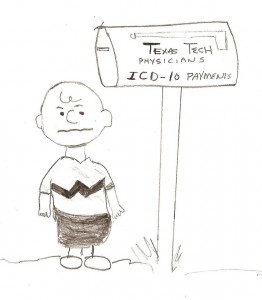 We have talked many times in this space about the system of International Classification
of Diseases (ICD) and its version 10, the new standardized system by which diseases
are classified. We are speeding toward the start date of October 1, 2015. We passed
the decision point on adopting ICD-10 a long time ago. Truthfully, there is not much
choice. According to federal regulations, all entities covered by the Health Insurance
Portability and Accountability Act of 1996 (HIPAA), including all health plans, health
data clearinghouses and health care providers, such as Texas Tech Physicians, who
transmit health information electronically, must use ICD-10 after the implementation
date, if we expect to be paid.
We have talked many times in this space about the system of International Classification
of Diseases (ICD) and its version 10, the new standardized system by which diseases
are classified. We are speeding toward the start date of October 1, 2015. We passed
the decision point on adopting ICD-10 a long time ago. Truthfully, there is not much
choice. According to federal regulations, all entities covered by the Health Insurance
Portability and Accountability Act of 1996 (HIPAA), including all health plans, health
data clearinghouses and health care providers, such as Texas Tech Physicians, who
transmit health information electronically, must use ICD-10 after the implementation
date, if we expect to be paid.Last weekend, Texas Tech Physicians took a big step in updating Cerner PowerChart to the latest version. It allows users to use ICD-9 and ICD-10 data fields to test our documentation, and results will be reported back to the physicians. By doing so, coders and physicians will work together on smoothing out the documentation process prior to ICD-10 implementation.
We’ve already learned there are considerable differences between the ICD-9 and ICD-10 in regard to the new version’s total volume and code length. The ICD-9 clinical modification (CM) consists of over 14,000 diagnostic codes that are three to five characters in length, and there are an additional 4,000 ICD-9-CM procedural codes that are three to four characters in length. The ICD-10-CM codes are three to seven characters in length and total 68,000 different codes, and its procedural codes bring the total to roughly 87,000 codes.
For more information about the changes to the ICD, watch this very thorough video by Texas Tech Physicians’ own Craig Bradley, M.D., who was phenomenally helpful in implementing our own EHR. It also features a funny comparison of health care providers’ frustration from the many delays in implementing ICD-10 to that of Charlie Brown as Lucy repeatedly moves a football he is about to kick.
Here, we’ll cover the basics of health care billing, since I know we have new people, some of whom are new to health care, join our team every week.
- When one of our physicians, or another health care provider for whom we can bill, treats a patient, he or she records the diagnosis, treatment plan and any procedure in the patient’s electronic health record (EHR).
- To manage our EHRs, Texas Tech Physicians uses Cerner PowerChart software, which we’ve just updated.
- Medical coders translate the providers’ notes into medical codes, which are standardized by the ICD.
- A claim is then filed with the patient’s public or private health insurer so we can be paid. Embedded in the claims are the medical codes we are discussing.
- The health insurer reviews this claim and either approves and pays the claim or denies it.
If a claim is denied, the insurance company will tell the provider why. Incorrect diagnostic codes are a common reason for claim denials. As changes come with ICD-10, providers like Texas Tech Physicians are concerned with continuing to receive payment for services and therefore want to be sure we are prepared to accurately document the care we provide according to ICD-10.
There is an expression in business that “cash is king,” and it simply means that businesses, including Texas Tech Physicians, must be paid in a timely manner for the services we provide. We need cash to keep things going. We do not need an increase in denials due to the implementation ICD-10. As with the frustrated football scenario, we also do not want to be like Charlie Brown waiting by the mailbox on Valentine’s Day for a card (or rather, a payment) that will never arrive because of a flawed ICD-10 rollout. We will work like the dickens to avoid this fate by demonstrating great attention to detail as we adopt ICD-10.
